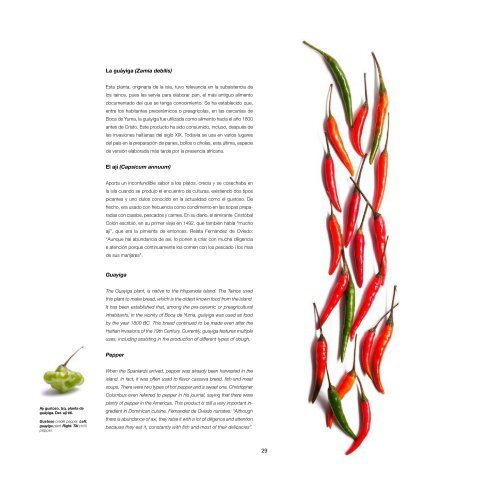Sabores-Ancestrales-Digital-1
Create successful ePaper yourself
Turn your PDF publications into a flip-book with our unique Google optimized e-Paper software.
La guáyiga (Zamia debilis)<br />
Esta planta, originaria de la isla, tuvo relevancia en la subsistencia de<br />
los taínos, pues les servía para elaborar pan, el más antiguo alimento<br />
documentado del que se tenga conocimiento. Se ha establecido que,<br />
entre los habitantes precerámicos o preagrícolas, en las cercanías de<br />
Boca de Yuma, la guáyiga fue utilizada como alimento hacia el año 1800<br />
antes de Cristo. Este producto ha sido consumido, incluso, después de<br />
las invasiones haitianas del siglo XIX. Todavía se usa en varios lugares<br />
del país en la preparación de panes, bollos o cholas, esta última, especie<br />
de versión elaborada más tarde por la presencia africana.<br />
El ají (Capsicum annuum)<br />
Aporta un inconfundible sabor a los platos, crecía y se cosechaba en<br />
la isla cuando se produjo el encuentro de culturas, existiendo dos tipos<br />
picantes y uno dulce conocido en la actualidad como el gustoso. De<br />
hecho, era usado con frecuencia como condimento en las sopas preparadas<br />
con casabe, pescados y carnes. En su diario, el almirante Cristóbal<br />
Colón escribió, en su primer viaje en 1492, que también había “mucho<br />
ají”, que era la pimienta de entonces. Relata Fernández de Oviedo:<br />
“Aunque hai abundancia de axi, lo ponen a criar con mucha diligencia<br />
e atención porque continuamente los comen con los pescado i los mas<br />
de sus manjares”.<br />
Guayiga<br />
The Guayiga plant, is native to the Hispaniola island. The Tainos used<br />
this plant to make bread, which is the oldest known food from the island.<br />
It has been established that, among the pre-ceramic or preagricultural<br />
inhabitants, in the vicinity of Boca de Yuma, guáyiga was used as food<br />
by the year 1800 BC. This bread continued to be made even after the<br />
Haitian invasions of the 19th Century. Currently, guayiga features multiple<br />
uses, including assisting in the production of different types of dough.<br />
Pepper<br />
Ají gustozo. Izq. planta de<br />
guáyiga. Der. ají tití.<br />
Gustoso creole pepper. Left.<br />
guayiga plant. Right. Titi chilli<br />
pepper.<br />
When the Spaniards arrived, pepper was already been harvested in the<br />
island. In fact, it was often used to flavor cassava bread, fish and meat<br />
soups. There were two types of hot pepper and a sweet one. Christopher<br />
Columbus even referred to pepper in his journal, saying that there were<br />
plenty of pepper in the Americas. This product is still a very important ingredient<br />
in Dominican cuisine. Fernandez de Oviedo narrates: “Although<br />
there is abundance of axi, they raise it with a lot of diligence and attention<br />
because they eat it, constantly with fish and most of their delicacies”.<br />
29


